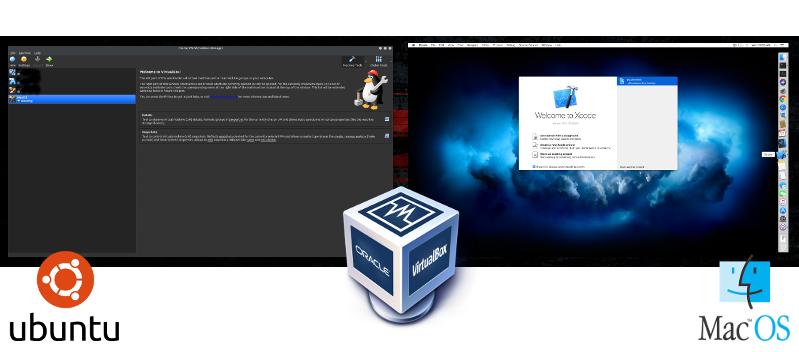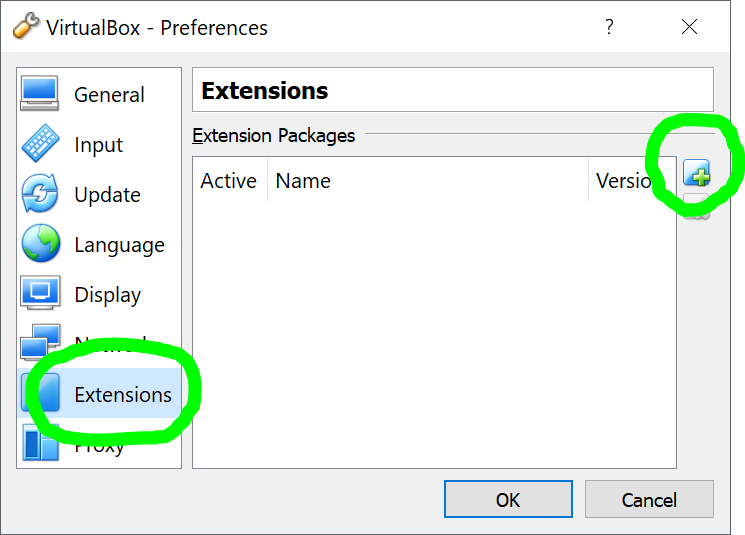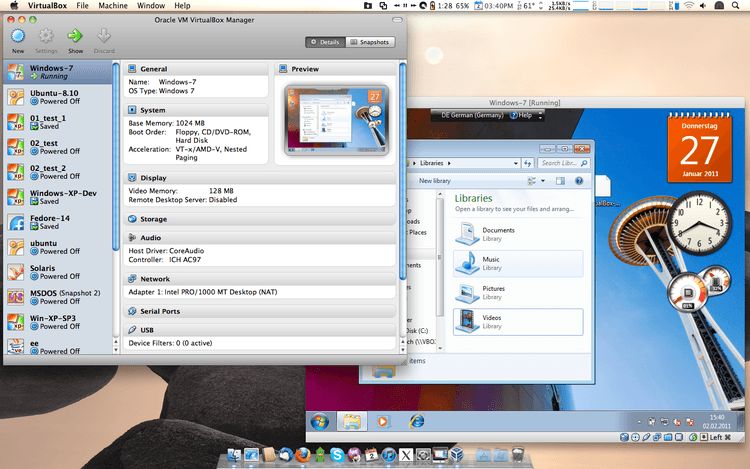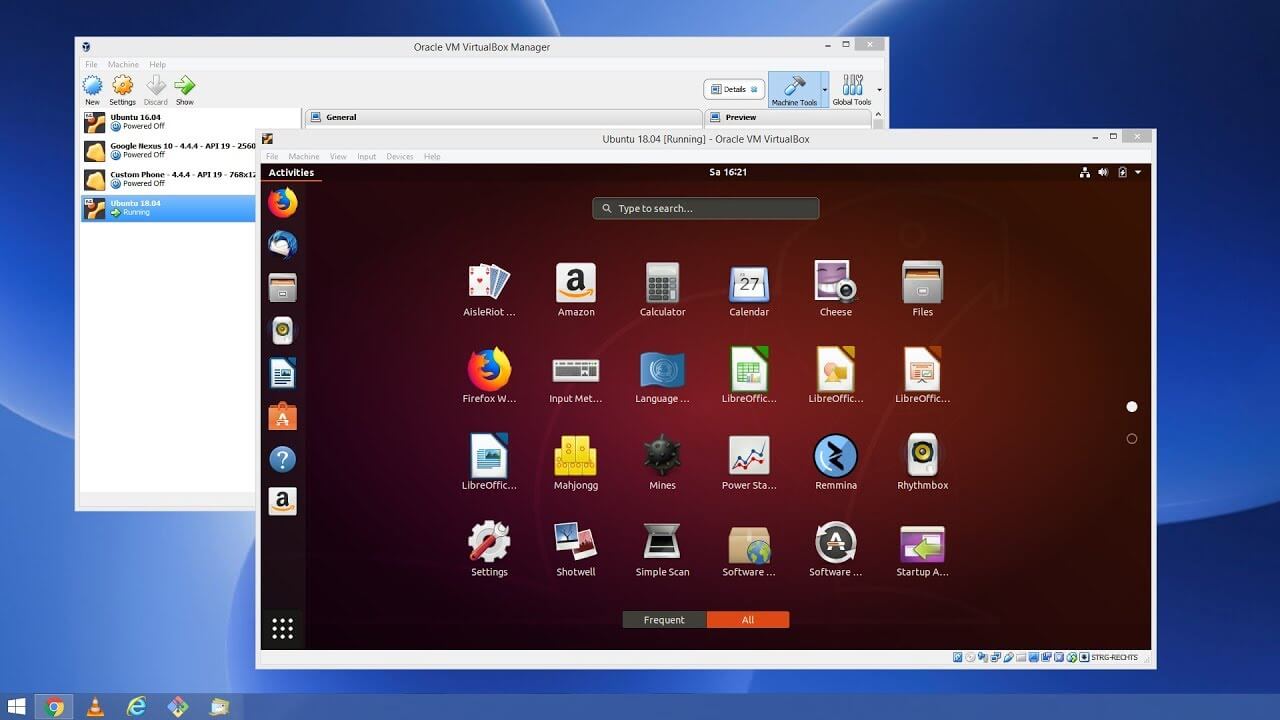Ubuntu Virtualbox For Mac Os X
First we need to allow the USB connection to pass through from OS X to Ubuntu, then we need to configure a few things in Ubuntu. Set up Virtualbox. First go ahead and click devices USB Settings from the menu bar at the top of the screen in OS X. I found a cool article which explains how to install macOS on VirtualBox, here is it: https://medium.com/@twister.mr/installing-macos-to-virtualbox-1fcc5cf22. Download Mac OS X El Capitan; Download and Install Virtualbox on your PC. Now, that you have downloaded OS X image file then in the next step, you will need to download Virtualbox from its website. While you download it then you need to install it on your system, the installation is quite an easy task but if you have no idea then click the link below to know about how to download and install.
Unfortunately, the KVM porting to OS X is not available yet, hence the easiest and most stable way to spin up Linux VMs in OS X is to use VMWare Fusion, Parallels or VirtualBox. Coming from Sun/Oracle and willing to use open source software as much as I can, VirtualBox is my favourite and natural choice.
My laptop is a late 2011 MacBook Pro running OS X 10.9 Mavericks. It's my personal laptop, so I use it for everything - browsing, e-mail, and programming. While the OS X experience is wonderful, application development can be frustrating. For example, right now I'm trying to develop a Boost Python module, and I am having trouble compiling it on OS X.
Mac Os X Virtualbox Vm
I intend to run my application in a Linux environment, so instead of learning the intricacies of porting my code and makefile to Mac OS X, I decided to install a local Ubuntu Server virtual machine (VM) on my MacBook. I installed Ubuntu Server instead of Ubuntu Desktop because I wanted to run a lightweight Linux environment, which should save laptop resources. I simply run the VM in the background, and ssh into it from the Mac terminal. Easy and awesome!
This entire tutorial should take approximately 20 minutes (not including download times).
Install VirtualBox
Download and install VirtualBox here. Theinstructions below were testing with VirtualBox 4.3.18 on OS X 10.9.5.
Download Ubuntu
Download the Ubuntu Server 14.04.01 LTS iso image.
Setting up the Virtual Machine (VM)
You can configure your virtual machine (VM) using the VirtualBox graphical program, but it's quicker to set it up from the command line. I've adapted these commands in part from this blog post.
The commands below will create a virtual machine called 'UbuntuServer',attach a 32 GB virtual hard drive, attach a DVDdrive loaded with the Ubuntu Server disk image, and allocate 1 GB of RAM. Max payne 3 for mac os torrent. We also attach a network card and set up port forwarding.
Start the VM for the first time
Ubuntu Virtualbox For Mac Os X64
For the first boot, we will start the VM with a graphical display so we can installthe Ubuntu operating system. From your OS X terminal:
The VM will boot from the DVD Drive, which has the Ubuntu Server installation CD image loaded.
Install Ubuntu Server
Install Ubuntu Server using the installation wizard with the default settings. The installer is interactive - it should take about 10 minutes to complete the installation. As part of the installation you will be asked to select a username and a password.
After installation is complete, the machine will reboot. Log in at the prompt.
Hint: If you accidentally click on the VM GUI window, VirtualBox may 'hijack' your mouse pointer to try passing it to the VM. If this happens and you lose your mouse pointer, press the left command key to get your mouse pointer back.
Install the OpenSSH Server
After installing the Ubuntu operating system and logging in to VM, to install the ssh server, issue the following command in the Ubuntu VM:
Now you can try logging into your virtual machine over ssh through port 2222, which has been set up to forward to port 22 of your VM. From the OS X terminal:
Congrats! :-)

For the rest of this installation guide, I recommend issuing all VM commands over ssh because the display is better than the VM GUI console, and you can easily paste commands into the Mac ssh terminal.
Install VirtualBox Guest Additions (for shared folders)
To share a folder from your host machine (i.e. Mac) with the VM, you need to installthe VirtualBox Guest Additions in the VM.
Before you can install the Guest additions, you need to install gcc and make into the VM. Make sure your laptop is connected to the internet (in the VM):
From the VirtualBox VM GUI window menu, select 'Devices -> Insert Guest Additions CD Image..'. If prompted, choose 'Force Unmount'.
This will insert the VirtualBox GuestAdditions installation CD into the VM's DVD drive. From the VM terminal (or, more comfortably, the ssh terminal), mount the CD drive and run the installation script. In the VM:
Finally, add your user to the vboxsf group so you can access shared folders (in the VM)
For the GuestAdditions installation to take effect, you need to reboot the VM. We'll take care of that in the next section when we boot the VM without a GUI.
Starting the VM without GUI.
Now that ssh has been installed and configured, you can run the VM in the background without a GUI window.

First, shutdown the VM using one of these methods:
- From the VM GUI, close the window and select 'Send Shutdown Signal', OR
- From the VM GUI menu, select 'Machine -> ACPI Shutdown' OR
- From the Mac terminal, issue
vboxmanage controlvm UbuntuServer poweroff
Next, start the VM without a GUI from the OS X terminal:
The VM will be running in the background. Give the VM a few moments to boot up, and then you can try to log in again over ssh as before from the OX X terminal: ssh -p 2222 <username>@localhost.
But you’ll quickly realize that Apple Mail lacks the essential email features that are must-have in today’s day and age and you’ll find yourself searching for the best Apple Mail alternative on Mac. Microsoft Outlook for Mac. Pricing: Free to download, but requires a Microsoft 365 Subscription starting $70/year. If you have Outlook for Mac, you can use it to access your Exchange account. See Add an email account to Outlook for instructions. Set up Exchange account access using Mac OS X 10.10 or later. If you're running Mac OS X version 10.10 or later, follow these steps to set up an Exchange email account: Open Mail, and then do one of the following. Mac mail client for exchange. Exchange Archive and Mac OS Mail client Hi, We have deployed Office 365 Premium for evaluation before we switch our provider. Now, we managed to set up users, we migrated our mailboxes and everything is almost ready for switch over. There is one issue however - as my inbox became very large, I have applied Archive solution on Exchange with. Looks like the latest version of Mac Mail on Sierra doesn't work with Exchange 2016. It works fine with our Exchange 2013 server. I am getting Unable to Verify account name or password. Outlook 2016 for Mac works fine and all windows clients are working fine so it seems to be a Mac Mail issue. Hi You may follow this below article for a work around to. Mac users have Apple Mail at their fingertips since it’s the default email client on the.
Access shared folders
To access your Mac home directory from the VM:
Your files should be there. If you get a 'permission denied', make sure you added your user to the vboxsf group.
Contratulations. Now you have a local lightweight Linux environment that you can access over ssh!
Quick Reference
To shutdown the VM:
You can also pause the VM instead of shutting it down:
To start the VM:
To log into the VM over ssh:
Additional Tweaks
Here are some solutions to other issues that may arise:
Configure the Grub Boot Loader
On one occasion I powered off the VM while it was booting. The next time time I tried to start the VM without the GUI, I could not log in over ssh because, unknown to me at the time, the VM was sitting in the GRUB bootloader menu waiting for my input.
You can configure GRUB to timeout by editing the VM's GRUB configuration file at/etc/default/grub with the line:

which willtimeout the bootloader with the default selection after 2 seconds whenever the systemis started after the last boot failed. For more info, see the Ubuntu GRUB 2 page.
Keeping SSH Alive when laptop sleeps
Configure the VM ssh server to keep connections alive by editing the VM's config file/etc/ssh/sshd_config and adding the following:
When your laptop sleeps, you may find that your ssh connection to the VM is terimnated.This is the result of some VirtualBox bug which has since been resolved provided that you change the VM's DNS resolution setting:
That did the trick for me.
Go TopIn Oracle VM VirtualBox, a virtual machine and its settings are described in a virtual machine settings file in XML format. In addition, most virtual machines have one or more virtual hard disks. These are typically represented by disk images, such as those in VDI format. The location of these files may vary, depending on the host operating system. See Section 3.1.1, “The Machine Folder”.
Global configuration data for Oracle VM VirtualBox is maintained in another location on the host. See Section 3.1.2, “Global Settings”.
By default, each virtual machine has a directory on your host computer where all the files of that machine are stored: the XML settings file, with a .vbox file extension, and its disk images. This is called the machine folder.
By default, this machine folder is located in a common folder called VirtualBox VMs, which Oracle VM VirtualBox creates in the current system user's home directory. The location of this home directory depends on the conventions of the host operating system, as follows:
On Windows, this is the location returned by the
SHGetFolderPathfunction of the Windows system library Shell32.dll, asking for the user profile. A typical location isC:Users.usernameOn Linux, Mac OS X, and Oracle Solaris, this is generally taken from the environment variable
$HOME, except for the userrootwhere it is taken from the account database. This is a workaround for the frequent trouble caused by users using Oracle VM VirtualBox in combination with the tool sudo, which by default does not reset the environment variable$HOME.A typical location on Linux and Oracle Solaris is
/home/and on Mac OS X isusername/Users/.username
For simplicity, we abbreviate the location of the home directory as $HOME. Using that convention, the common folder for all virtual machines is $HOME/VirtualBox VMs.
As an example, when you create a virtual machine called 'Example VM', Oracle VM VirtualBox creates the following:
A machine folder:
$HOME/VirtualBox VMs/Example VM/In the machine folder, a settings file:
Example VM.vboxIn the machine folder, a virtual disk image:
Example VM.vdi.
This is the default layout if you use the Create New Virtual Machine wizard described in Creating Your First Virtual Machine. Once you start working with the VM, additional files are added. Log files are in a subfolder called Logs, and if you have taken snapshots, they are in a Snapshots subfolder. For each VM, you can change the location of its snapshots folder in the VM settings.
You can change the default machine folder by selecting Preferences from the File menu in the Oracle VM VirtualBox main window. Then, in the displayed window, click on the General tab. Alternatively, use the VBoxManage setproperty machinefolder command. See VBoxManage setproperty.
In addition to the files for the virtual machines, Oracle VM VirtualBox maintains global configuration data in the following directory:
Linux and Oracle Solaris:
$HOME/.config/VirtualBox.Windows:
$HOME/.VirtualBox.Mac OS X:
$HOME/Library/VirtualBox.

Oracle VM VirtualBox creates this configuration directory automatically, if necessary. You can specify an alternate configuration directory by either setting the VBOX_USER_HOME environment variable, or on Linux or Oracle Solaris by using the standard XDG_CONFIG_HOME variable. Since the global VirtualBox.xml settings file points to all other configuration files, this enables switching between several Oracle VM VirtualBox configurations.
In this configuration directory, Oracle VM VirtualBox stores its global settings file, an XML file called VirtualBox.xml. This file includes global configuration options and a list of registered virtual machines with pointers to their XML settings files.
The following table gives a brief overview of the configuration data locations on an Oracle VM VirtualBox host.
Table 3.1 Configuration File Locations
Setting | Location |
|---|---|
Default machines folder |
|
Default disk image location | In each machine's folder |
Machine settings file extension |
|
Media registry | Each machine settings file Media registration is done automatically when a storage medium is attached to a VM |
Oracle VM VirtualBox uses XML for both the machine settings files and the global configuration file, VirtualBox.xml.
All Oracle VM VirtualBox XML files are versioned. When a new settings file is created, for example because a new virtual machine is created, Oracle VM VirtualBox automatically uses the settings format of the current Oracle VM VirtualBox version. These files may not be readable if you downgrade to an earlier version of Oracle VM VirtualBox. However, when Oracle VM VirtualBox encounters a settings file from an earlier version, such as after upgrading Oracle VM VirtualBox, it attempts to preserve the settings format as much as possible. It will only silently upgrade the settings format if the current settings cannot be expressed in the old format, for example because you enabled a feature that was not present in an earlier version of Oracle VM VirtualBox.
In such cases, Oracle VM VirtualBox backs up the old settings file in the virtual machine's configuration directory. If you need to go back to the earlier version of Oracle VM VirtualBox, then you will need to manually copy these backup files back.
We intentionally do not document the specifications of the Oracle VM VirtualBox XML files, as we must reserve the right to modify them in the future. We therefore strongly suggest that you do not edit these files manually. Oracle VM VirtualBox provides complete access to its configuration data through its the VBoxManage command line tool, see VBoxManage and its API, see Chapter 4, Oracle VM VirtualBox Programming Interfaces.
Copyright © 2004, 2020 Oracle and/or its affiliates. All rights reserved. Legal Notices
